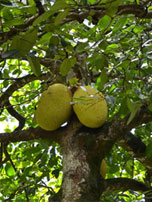SHAHEED KARTAR SINGH SARABHA AYURVEDIC MEDICAL COLLEGE & HOSPITAL
Affiliated to Guru Ravidas Ayurved University, Hoshiarpur Punjab
Affiliated to Guru Ravidas Ayurved University, Hoshiarpur Punjab

Botanical Name : Artocarpus heterophyllus Lam.
Family : Moraceae
Introduction :
Latin name: Artocarpus – artos = bread, carpos = fruit, bread fruit; heterophyllus – hetero = unequal, dissimlar leaved.
Names in different Indian languages :
English : Jackfruit, Jack tree
Hindi : Kathal, cakki
Kannada : Halasu
Malayalam : Plavu, pilavu
Sanskrit : Panasa
Tamil : Murasabalam, plamaram
Panasa
Folk : Katahal, Phanasa
Synonyms :
Panasa, Kantakiphala, Ativrihatphala, Aamaashayaphala, Mahasaija, Phalin, Phalavrukshak, Kashtaphala, Aashay, Garbhakantak,Bruhatphal, Sthulkantaphala.
Artocarpus integrifolia Linn. f.
Varieties & adulterants – (CV – controversy, AD – adulterants) :
Artocarpus altilis
Morphology :
A huge tree grows 15 – 20 mts. high.
Leaves – simple,alternate, thick with three veins.
flowers – unisexual.
Fruit – multiple, 10-20 cms. long and 16-30 cm. broad having thorns all over the surface.
It weighs about 5 to 20 kg. Pulp of unripe fruit is white while that of ripe is yellow. Seeds – 2.5 to 3 cm. long, slightly triangular and contains oil. It bears flowers in November and fruits in April and May. Fruits also hang from the trunk. Fruits and seeds are edible Seeds are roasted and eaten while fibrous part is cooked as vegetable.
Fruits come in a wide range of sizes, shapes, and colors. The tiny floating plants known as water-meal are only 1 to 2 mm (0.04 to 0.08 in) wide and have very small flowers. Their miniature ovaries develop into fruits that are barely visible. Watermelons, on the other hand, may be more than 60 cm (24 in) long and weigh more than 20 kg (45 lb). Jackfruits, found in the tropics, can weigh more than 40 kg (90 lb). Diverse fruit shapes abound, including round grapefruits, oval eggplants, elongated bean pods, and star-shaped star anise. Pale to intense shades of orange, red, yellow, and even purple can be found in fleshy fruits, while dry fruits display many tones of brown.
Distribution & Habitat :
All over in India. specially in southern region.
Chemical constituents :
cycloartenone, cycloartenol , beta-sitosterol,flavonoids, artocarpesin , norartocarpetin
Properties :
Guna : guru. snigdha:
Rasa : madhur, kashaya;
Vipaka : madhur:
Virya : sheeta:
Dosha:vatapittashamak. (Raw fruit. kaphavatavardhak).
Karma : rucyam, tarpanam, bramhanam, vrishyam, balyam, hridyam
acrid, astringent,thermogenic, laxative, diurtic
Indication :
Kandu, kusta, murakrichram
diarrhoea, asthma, skin diseases, mouth ulcers, Eczema,T.B, tumour,pruritus, diabetes, leucoderma, anorexia
Part used :
Whole plant
Dosage :
Leaf juice 10-15 ml
Powder 2-4 g
Decoction 50-100 ml
External use :
Latex is used as anti-inflammatory and wound healing agent. Phanasamba is effective in stomatitis.
Internal uses :
Pulp is guru and constipative Decoction of root is an astringent and is given in diarrhoea. Ripe fruit is spermatogenic, brimhana and used in bleeding disorders. Decoction of roots and leaves is useful in skin disorders while decoction of leaves is given as antidote to poisons.
